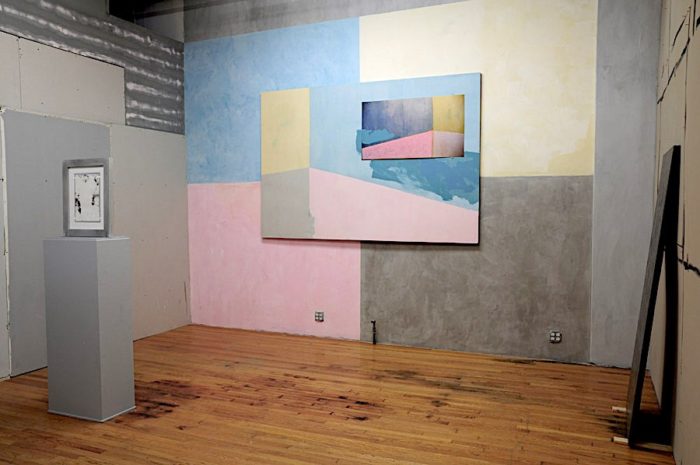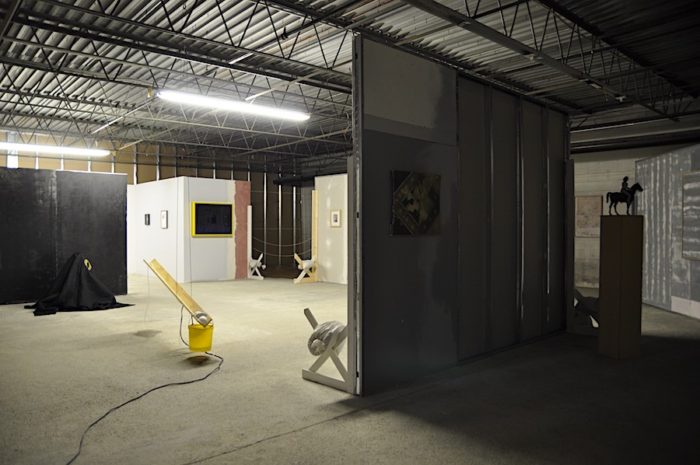
Congratulations on your 5 year anniversary for Cathouse FUNeral / Proper. Can you give us a quick history of how it all began?
Much like in a dream, where you discover a room in your house that you never knew was there before, I was able to take on an empty space down the hall in the ex-funeral home where my live/work studio was. Initially, I was not thinking “gallery,” but rather studios or a school or someplace to make and exchange art and ideas. So I built five rooms––five studios––in this new space, the fifth of which became the gallery, Cathouse FUNeral. I have an artist friend in New Orleans, Brad Benischek, who at the time was looking for a place in NYC to show a large series of works on paper, so I offered him this fifth room, then thought that after I would rent it out, it was the room that was meant to bring a profit to the whole venture. Yet, instead of being the profit room it became the prophet room, a space for art revelations!
What is your philosophy in curating shows?
Philosophy is not really the word that I would use, I’ve been wondering if one could evolve a political philosophy based on the actions that have become Cathouse FUNeral / Proper, but I certainly haven’t codified such a thing! The intuitions that determined methods for organizing art and its artists were not premeditated or systematic, rather, approaches evolved based on basic humanity, enthusiasm and aesthetics. That said, the show we’re about to open is the closest thing I’ve done to a personal, psychological statement about what motivates me as regards the gallery, so if there is a philosophy it is probably there in the room somewhere, the sum total of all the art objects. Though now that you ask, I’m thinking that this show bookends perfectly with the first solo-show I gave myself at Cathouse FUNeral in summer of 2014 that was titled, somewhat ironically, Heroic Social Worker, this new exhibition represents the other side of a dialectic that I sometimes evoke regarding the gallery, that being “Youthful Narcissism.”

Please discuss the upcoming 5-year anniversary show at the gallery. Who is participating, when does it open and what is the show about?
Yes, yes, those are the essential questions! Cathouse FUNeral moved operations to 524 Project Space in 2016 and rebranded as Cathouse Proper, so we are over two years in this new, spectacular location in Carroll Gardens. I don’t recall which came first, but at some point, I realized that an anniversary show could not include everyone and certainly not everything that we had done, obviously, and attempting to do so would not only be incomplete but possibly even nostalgic. I’ve organized large group shows before that included the salvaged walls from the FUNeral gallery, what I call “harvestings,” so in a sense we’ve been dragging along the past into the present from the beginning of the project. So this new, all-encompassing, anniversary exhibition needed to have its own character. Hence, last summer I was able to work outside, upstate on two large-scale fresco variations of the original Cathouse FUNeral gallery logo, which has always been rich in meaning, and several other supporting works about the gallery itself and my role as the progenitor. So that’s what is being shown: iconic representations of Cathouse FUNeral exhibited in Cathouse Proper @ 524 Projects, opening Saturday, April 27, 6-9pm, through June 2.
How do you start the process of putting an exhibition together?
Since we are not a non-profit nor do I really “represent” artists the process is quite free-formed. We program in a particularly well-proportioned space with very high ceilings, so I try to discover and motivate works that will look good in there, that can address the magic of the room in a meaningful way. This begins with conversations with artists; I try to get a sense of how the space will be used, imagine it in there, how it fits in with what we’ve been doing, etc. then if everything is in order, the artist makes it happen.

What is your favorite show at your gallery in the past 5 years?
I wouldn’t say “favorite,” each show truly had surprising and challenging elements, but perhaps the most indicative of what has made the Cathouse project unique would be two shows, both group shows: Final Harvestings, the last show in the FUNeral space that hung work on the cut through and exposed layers of aesthetic history that had accumulated in the gallery walls, and Leaving Home: Cathouse FUNeral Migrates North a seventeen-artist group show hung on the harvested, transported and reconfigured walls of the original FUNeral gallery, that took place summer of ‘17 in a raw 3500 sq ft space in Beacon, NY near Dia. For that show, the last (so far) of the four itinerant, off-site exhibitions, we were also able to assemble a catalogue with relevant texts that had inspired the show provided with permission from art historians Rachel Cohen, Cécile Fromont, Boris Groys and NY Times contributor Moises Velasquez-Manoff.
Do you have any special projects/shows coming up?
As it is, we are officially only planned out through this upcoming anniversary show, then summer we’ll be closed. There are a lot of balls in the air for next season, beginning in the fall, but nothing yet that I’m ready to report, but thank you for asking.
